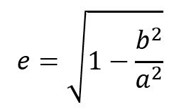How can I measure the ellipticity of my laser beam?
Thursday, March 14, 2024
Thursday, March 14, 2024
In an ideal world, when your laser beam would be described as Gaussian, its profile would be a TEM00 in 3D, perfectly centered on your optical axis and moving along it. For those of you who have already done some work in the lab, no matter how minor it was, you realize quickly that real experimentations differ quite a lot from theory. If you expect the cross-section of your beam to be a perfect circle, think again!
As for a lot of things in science, you can find multiple definitions for the same concept. But, when thinking of ellipticity, what you’re generally interested in is how far from a circle your ellipse is. The most common way to calculate this concept is to take the ratio of the difference between half the major axis and half the minor axis divided by half the major axis.



This definition is also called flattening. You could also look for eccentricity instead, which is similar, but you square every term of the equation and then take the square root of the result.


The key point to remember here is both concepts use the major and the minor axis dimensions of an ellipse in their definitions. That’s what we will be looking for then!
Laser output measurement solves numerous problems for organizations across all industries. Download the guide below. Gentec-EO's high-accuracy laser beam measurement instruments help engineers, scientists and technicians in all sorts of laser applications from the factory to the hospital, laboratory and research center. Learn about our solutions for these measurement types:
You still have many options to choose from here as to how you’re going to define your ellipse, and, depending on what your beam really looks like, your choice may better describe the beam you have at hand. In every scenario, you will first need some device or technique that gives you an intensity profile of your beam, meaning what its power distribution looks like.
If you’re unfamiliar with the concept of beam size and how to measure it, read about it in our beginner’s guide on spot size measurement and in our laser beam size measurement article.
If you don’t have the required equipment, our beam profiling cameras would be the perfect partner for your endeavors.
In our PC-BEAMAGE software, you will have to select how you would like the profiler to define a couple of parameters, like beam center, cross-section diameter, and ellipse orientation. Based on your definition of the ellipse, our software will directly give you the ellipticity. You could also do the calculations yourself using the formulas above.
Now that you have the right tools and understand the concepts, you’re ready to tackle the gap you’re likely to encounter between theory and real-life applications. Or simply put, how flat your ellipse is compared to a circle.